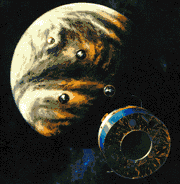Pioneer 13
Pioneer Venus Multiprobe
Part of the Pioneer program
 Pioneer Venus Multiprobe carried 4 probes designed to perform in-situ atmospheric measurements. Released from the carrier vehicle in mid-November 1978, the probes entered the atmosphere at 41,600 km/hr and carried a variety of experiments to measure chemical composition, pressure, density, and temperature of the mid-to-lower atmosphere. The probes, consisting of 1 larger heavily instrumented probe and 3 smaller simpler probes, were targeted at different locations. The large probe entered near the planet's equator (in daylight). The small probes were sent to different spots - one each to the northern hemisphere, day and night sides of the planet. Although not designed to survive impact with the surface, one small probe (the Day probe) did survive and sent temperature data from the surface for 67 minutes until its batteries were depleted. The carrier vehicle, not designed for atmospheric reentry, followed the probes into the Venusian environment and relayed data about the characteristics of the extreme outer atmosphere until it was destroyed by atmospheric heating.
Pioneer Venus Multiprobe carried 4 probes designed to perform in-situ atmospheric measurements. Released from the carrier vehicle in mid-November 1978, the probes entered the atmosphere at 41,600 km/hr and carried a variety of experiments to measure chemical composition, pressure, density, and temperature of the mid-to-lower atmosphere. The probes, consisting of 1 larger heavily instrumented probe and 3 smaller simpler probes, were targeted at different locations. The large probe entered near the planet's equator (in daylight). The small probes were sent to different spots - one each to the northern hemisphere, day and night sides of the planet. Although not designed to survive impact with the surface, one small probe (the Day probe) did survive and sent temperature data from the surface for 67 minutes until its batteries were depleted. The carrier vehicle, not designed for atmospheric reentry, followed the probes into the Venusian environment and relayed data about the characteristics of the extreme outer atmosphere until it was destroyed by atmospheric heating.
Despite their drastically different roles, the Orbiter and Multiprobe were very similar in design. The use of identical systems (including flight hardware, flight software, and ground test equipment) and incorporation of existing designs from previous missions (including OSO and Intelsat) allowed the mission to meet its objectives at minimum cost.
Spacecraft
Multiprobe bus (Carrier vehicle) - Spin stabilized. Body mounted solar panels provided 241 W.
Large probe - Consisted of 3 parts: a forward heat shield, an aft protective cover and a spherical titanium pressure vessel (73 cm dia). Total probe diameter was 1.5 m. After intial deceleration, the heat shield and protective cover were jettisoned, and a parachute was deployed to further slow descent. After parachute deployment, the exposed pressure vessel and its instrument package descended for about 1 1/2 hour before impact. During descent, the instruments were powered by batteries. Nine observation windows (8 sapphire and 1 diamond) were provided for instrument observations. 3 pressure vessel penetrations were also provided as inlets for direct atmospheric sampling. The probe weighed 315 kg.
Small probes - Consisted of 3 parts: a forward heat shield, an aft protective cover and a spherical titanium pressure vessel. Unlike the large probe, the heat shield and protective cover remained attached to the pressure vessel, and no parachutes were deployed. Prior to atmospheric entry, each probe deployed a yo-yo despin device to reduce its spin rate from 48 to 15 rpm. Total probe diameter was 0.8 m in diameter. Betteries provided power during descent (which lasted approx. 75 minutes). Each probe weighed 75 kg.
Payload
Multiprobe bus (Carrier vehicle)
- Ion Mass Spectrometer (BIMS) - studied the composition of the upper atmosphere.
Neutral Mass Spectrometer (BNMS) - studied the composition of the
upper atmosphere.
Large probe:
Atmospheric Structure (LAS)
Nephelometer (LN) - studied cloud particles
Cloud Particle Size Spectrometer (LCPS) - measured particle size and shape
Gas Chromatograph (LGC) - studied atmospheric composition
Infrared Radiometer (LIR) - monitored the distribution of infrared radiation
Neutral Particle Mass Spectrometer (NPMS) - studied atmospheric composition
Solar Flux Radiometer (LSFR) - examined solar flux penetration into the atmosphere
Differential Long Base Line Interferometer (DLBI)
Atmospheric Propagation (MPRO) - temperature, pressure, and acceleration measurements
Small probes:
Nephelometer
Temperature, pressure, and acceleration sensors
Net flux radiometer - mapped the distribution of sources and sinks of radiative energy in the atmosphere.
Radio signals from all four probes were also used to characterize winds, turbulence, and propogation in the atmosphere.
| Country of Origin | United States |
| Customer/User | NASA, Ames Research Center |
| Manufacturer(s) | Hughes |
| Size | Cylinder: 2.5 m dia. x 2.9 m tall |
| Orbit | Venus direct trajectory |
| Design Life | 4 months |
| Related Sites | Pioneer Home Page |
Launch Facts
| Name | Int'l Desig. | Date | Site | Vehicle | Orbit | Mass(kg) |
| Notes | ||||||
| Pioneer 13 | 1978-078A | 8/8/78 | ESMC | Atlas Centaur | Venus | 904 |
| Dropped 4 probes in Venus atmosphere 12/9/78; burned up in atmosphere on same day | ||||||
Information in The Mission and Spacecraft Library is provided without warranty or guarantee. USE AT YOUR OWN RISK.